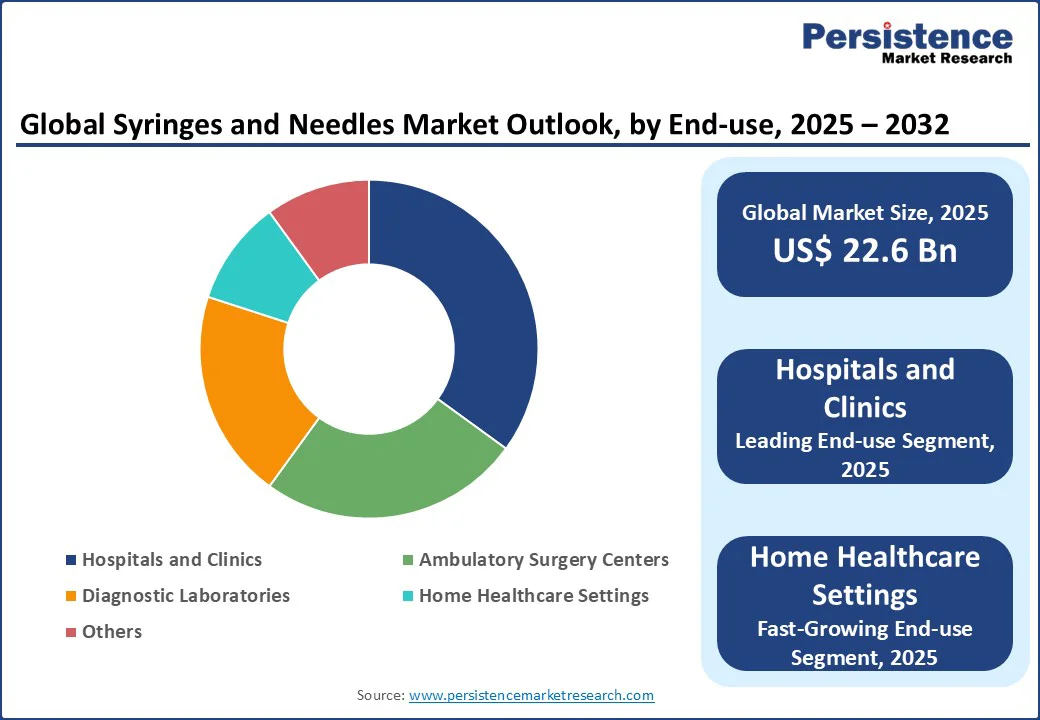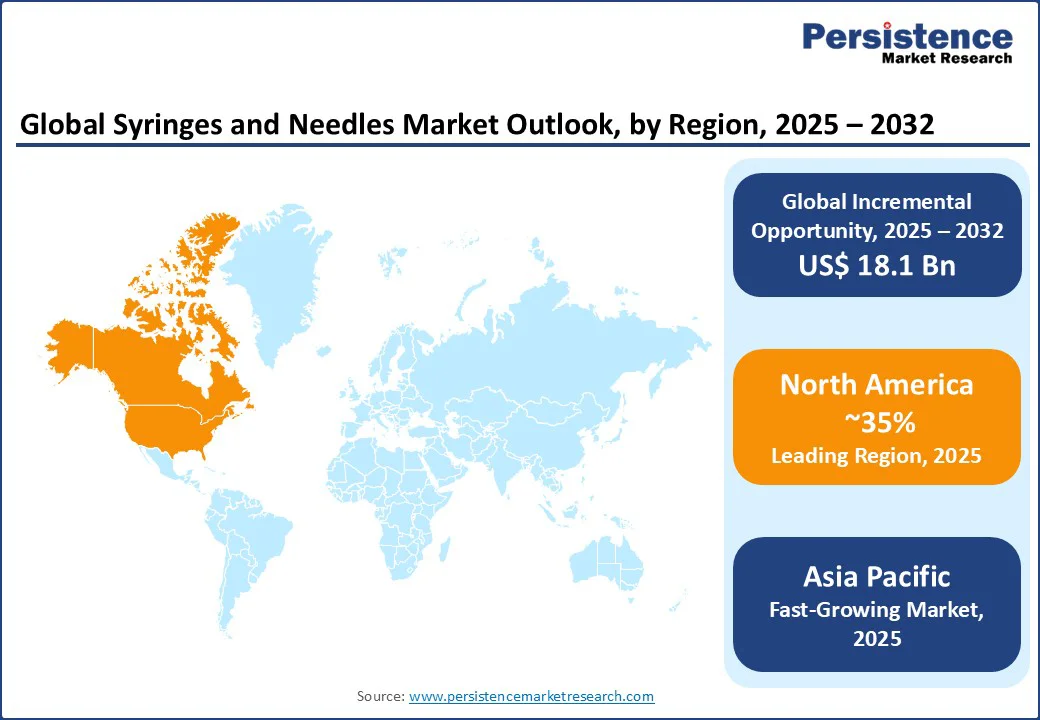ID: PMRREP3322| 187 Pages | 8 Sep 2025 | Format: PDF, Excel, PPT* | Healthcare

The global syringes and needles market size is likely to be valued at US$26.6 Bn in 2025 and a projected value of US$44.7 Bn by 2032, registering CAGR of 7.7% during the forecast period 2025 - 2032.
Key Industry Highlights:

| Global Market Attribute | Key Insights |
|---|---|
| Syringes and Needles Market Size (2025E) | US$ 26.6 Bn |
| Market Value Forecast (2032F) | US$ 44.7 Bn |
| Projected Growth (CAGR 2025 to 2032) | 7.7% |
| Historical Market Growth (CAGR 2019 to 2024) | 7.0% |
The increasing need for chronic disease management, widespread vaccination programs, and advancements in syringe and needle technology propels the growth.
Additionally, the focus on syringe and needle sterilization and eco-friendly syringes is gaining momentum as healthcare providers prioritize infection control and sustainability. The market is further supported by the growing use of prefilled syringes for precise drug delivery in osteoarthritis treatments, Botox, and other specialized applications, catering to the evolving needs of healthcare systems worldwide.
he increasing burden of chronic conditions, such as diabetes and osteoarthritis, serves as a pivotal driver for the syringes and needles market. The growing number of patients requiring regular insulin administration for diabetes management has significantly boosted demand for insulin syringes and safety needles, as these tools enable precise and safe delivery of medication.
Similarly, the rising incidence of osteoarthritis has led to greater use of syringe-based treatments, such as hyaluronic acid injections, which help alleviate joint pain and improve mobility. This trend is particularly pronounced in an aging population, where chronic conditions are more prevalent.
The shift toward outpatient care and self-administration further amplifies the need for user-friendly prefilled syringes and disposable syringes, which allow patients to manage their conditions at home with minimal professional assistance. Healthcare providers are increasingly recommending these advanced syringe systems to improve patient compliance and reduce hospital visits, thereby enhancing overall quality of life.
Additionally, the growing awareness of chronic disease management in emerging markets has led to increased adoption of biocompatible needle materials, which ensure safety and comfort during repeated use. The integration of syringe and needle technology with digital health platforms, such as smart insulin pens, is also fostering innovation, making it easier for patients to monitor and manage their conditions effectively.
The elevated cost of safety-engineered syringes and retractable needles poses a significant restraint on market growth, particularly in cost-sensitive regions. These advanced products are designed to minimize needlestick injuries and enhance patient and healthcare worker safety, but their sophisticated manufacturing processes and specialized materials, such as high-grade plastics and stainless steel, result in higher production costs. This makes them less accessible for healthcare facilities in developing economies, where budget constraints often dictate the use of conventional, less expensive syringes.
The cost disparity creates a barrier for widespread adoption, especially in rural and underserved areas where healthcare infrastructure is limited. Furthermore, the need for specialized training to use these advanced systems adds to the overall cost, as healthcare providers must invest in staff education to ensure proper handling.
This financial burden can deter smaller clinics and hospitals from transitioning to safety needles, limiting market penetration in regions with constrained healthcare budgets and slowing the overall adoption of safer, more advanced syringe technologies.
The growing emphasis on sustainability in healthcare presents a significant opportunity for the development and adoption of eco-friendly syringes made from biodegradable plastics and recyclable materials. As healthcare systems worldwide face increasing pressure to reduce medical waste and environmental impact, manufacturers have a unique chance to innovate by creating sustainable alternatives to traditional syringes. These eco-friendly syringes can address concerns related to the disposal of disposable syringes and vaccination needles, which contribute significantly to medical waste in hospitals and clinics.
By developing products that align with global sustainability goals, manufacturers can differentiate their offerings and capture market share in environmentally conscious markets. Additionally, the adoption of syringe and needle sterilization techniques that minimize environmental impact can further enhance the appeal of sustainable solutions.
This opportunity extends to partnerships with healthcare providers and governments to implement green initiatives, such as recycling programs for safety needles and prefilled syringes, fostering a circular economy in medical device manufacturing. The focus on sustainability also opens doors for innovation in biocompatible needle materials that balance environmental benefits with performance, creating new revenue streams in both developed and emerging markets.
Syringes dominate with a 60% market share in 2025, driven by the widespread use of disposable syringes and prefilled syringes in insulin administration, vaccination, and blood collection. Their versatility, ease of use, and ability to meet diverse medical needs make them indispensable in hospitals and clinics and home healthcare settings.
Needles are the fastest-growing segment. The increasing adoption of safety needles and retractable needles, driven by regulatory mandates to prevent needlestick injuries, is boosting demand, particularly in diagnostic laboratories and ambulatory surgery centers.
Plastics hold the largest share 65% in 2025, owing to their affordability, lightweight properties, and widespread use in disposable syringes and vaccination needles. Plastic syringes are preferred in home healthcare settings for their ease of use and cost-effectiveness, making them a staple in high-volume medical applications.
Stainless steel is the fastest-growing segment, driven by its durability and use in safety needles and biocompatible needle materials for specialized applications such as ophthalmic procedures and dental applications, where precision and strength are critical.
Insulin administration leads with a 30% share in 2025, driven by the global rise in diabetes cases requiring insulin syringes and safety needles. The application’s dominance is supported by the increasing need for self-administration among diabetic patients, particularly in home healthcare settings.
Vaccination is the fastest-growing segment, fueled by global immunization programs and the adoption of prefilled syringes and vaccination needles for diseases such as influenza, HPV, and COVID-19, supported by government-backed vaccination campaigns.
Hospitals and clinics dominate with a 40% share in 2025, driven by high procedural volumes for insulin administration, vaccination, and blood collection. These settings rely heavily on disposable syringes and safety-engineered syringes to ensure patient safety and infection control.
Home healthcare settings are the fastest-growing segment, fueled by the rise in self-administration of medications such as insulin and the increasing adoption of prefilled syringes and home healthcare devices for chronic disease management.

North America holds a 35% market share in 2025, with the United States as the primary contributor, driven by its advanced healthcare infrastructure, high prevalence of chronic diseases, and robust regulatory framework.
The U.S. market benefits from the widespread use of insulin syringes and safety needles for diabetes management, as the country faces a significant burden of chronic conditions such as diabetes and obesity. The adoption of prefilled syringes in hospitals and clinics is growing, particularly for vaccination and osteoarthritis treatments, due to their convenience and precision.
The U.S. healthcare system’s emphasis on patient safety has led to increased demand for safety-engineered syringes and retractable needles, supported by regulations such as the Needlestick Safety and Prevention Act. The rise of home healthcare settings is another key driver, as aging populations and patients with chronic conditions increasingly rely on home healthcare devices for self-administration.
Europe accounts for a 25% market share in 2025, with Germany, France, and the United Kingdom as leading contributors. Germany’s advanced medical device industry drives demand for safety needles and prefilled syringes in hospitals and clinics, particularly for insulin administration and vaccination. The country’s strong healthcare system and emphasis on precision medicine support the adoption of biocompatible needle materials for applications such as ophthalmic procedures and dental applications.
France’s robust vaccination programs, backed by the EU Health Programme, fuel demand for vaccination needles and disposable syringes, with a focus on immunization for infectious diseases and preventive healthcare.
The UK’s aging population and increasing prevalence of osteoarthritis drive demand for syringe-based treatments in ambulatory surgery centers, where prefilled syringes are used for hyaluronic acid injections and Botox procedures.
Europe’s stringent regulatory environment, including the EU Medical Device Regulation (MDR), promotes syringe and needle sterilization and encourages the development of eco-friendly syringes to address environmental concerns. The region’s focus on sustainability and patient safety, combined with investments in healthcare innovation, creates a favorable environment for market growth.
Asia Pacific is the fastest-growing region, with a 25% market share in 2025 and a CAGR of 8.3%, led by China and India. China’s rapidly expanding healthcare sector and increasing diabetes prevalence drive demand for insulin syringes, safety needles, and prefilled syringes. The country’s focus on healthcare modernization, coupled with government initiatives to improve access to medical services, supports the adoption of disposable syringes in hospitals and clinics.
The growing middle-income groups and urbanization in China are also increasing demand for home healthcare devices, particularly for self-administration of medications. India’s Universal Immunization Programme and rising chronic disease burden fuel demand for vaccination needles and insulin syringes, with government-backed healthcare schemes such as Ayushman Bharat enhancing access to medical supplies in rural and urban areas. The country’s large population and increasing healthcare awareness drive the adoption of safety-engineered syringes in diagnostic laboratories and ambulatory surgery centers.

The global syringes and needles market is highly competitive, with a mix of global and regional players focusing on innovation, sustainability, and market expansion. Key players include Nipro Medical, Terumo, Cardinal Healthcare, Asahi Polyslider, Cartel Healthcare, Changzhou Mingle Medical Equipment, Misawa Medical Industry Co., Ltd., Fanmei Medical, Henke Sass Wolf, HI-TECH Medics, Iscon Surgicals Ltd., and Kanghua Medical.
These companies compete on product quality, technological advancements, and distribution efficiency, with a strong emphasis on safety-engineered syringes, prefilled syringes, and eco-friendly syringes to meet evolving healthcare needs.
The syringes and needles market are projected to reach US$26.6 Bn in 2025, driven by rising healthcare needs and vaccination programs.
The increasing prevalence of chronic diseases such as diabetes and osteoarthritis drives demand for insulin syringes and safety needles.
The syringes and needles market are expected to grow at a CAGR of 7.7% from 2025 to 2032, fueled by innovation and healthcare expansion.
Development of eco-friendly syringes offers opportunities to address sustainability and medical waste concerns.
Leading players include Nipro Medical, Terumo, Cardinal Healthcare, Asahi Polyslider, and Changzhou Mingle Medical Equipment.
| Report Attribute | Details |
|---|---|
| Historical Data/Actuals | 2019-2024 |
| Forecast Period | 2025-2032 |
| Market Analysis | Value: US$ Bn, Volume: As Applicable |
| Geographical Coverage |
|
| Segmental Coverage |
|
| Competitive Analysis |
|
| Report Highlights |
|
| Customization and Pricing | Available upon request |
By Product Type
By Material
By Application
By End-use
By Region
Delivery Timelines
For more information on this report and its delivery timelines please get in touch with our sales team.
About Author